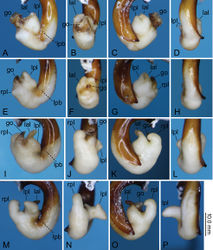Pterostichus atsumidakensis
| Notice: | This page is derived from the original publication listed below, whose author(s) should always be credited. Further contributors may edit and improve the content of this page and, consequently, need to be credited as well (see page history). Any assessment of factual correctness requires a careful review of the original article as well as of subsequent contributions.
If you are uncertain whether your planned contribution is correct or not, we suggest that you use the associated discussion page instead of editing the page directly. This page should be cited as follows (rationale):
Citation formats to copy and paste
BibTeX: @article{Sasakawa2023DeutscheEntomologischeZeitschrift70, RIS/ Endnote: TY - JOUR Wikipedia/ Citizendium: <ref name="Sasakawa2023Deutsche Entomologische Zeitschrift70">{{Citation See also the citation download page at the journal. |
Ordo: Coleoptera
Familia: Carabidae
Genus: Pterostichus
Name
Pterostichus atsumidakensis Sasakawa & Mitsuduka sp. nov. – Wikispecies link – ZooBank link – Pensoft Profile
Type material
Holotype, ♂, Take-no-koshi, Yuatsumi, Tsuruoka-shi, Yamagata Prefecture, Japan (MGRS: 54SUH79821 75877; 38.62327968°N, 139.61944580°E), 2–24. vi. 2022, subterranean baited trap, Y. Mitsuduka leg., in the collection of NSMT (Fig. 2C). Paratype, 1♀, same data as the holotype.
Description
Body length (mm). ♂ (n = 1), BLm 16.54, BLl 14.91, BLc 14.36; ♀ (n = 1), BLm mm, BLl 14.62, BLc 14.09.
Head. Mandibular surface smooth, except for right mandible of the paratype female, which has several short wrinkles at middle. Anterior–posterior length of tempora about twice anterior–posterior length of eye. Surface of clypeus irregularly uneven. Antennal segment 2 with four setae in the holotype male, with one seta on left and two on right in the paratype female. Mentum tooth deeply bifid; width between paired apices apparently less than three times anterior–posterior length between level of mentum apices to level of innermost part of median notch.
Pronotum. Lateral margin arcuate on apical 3/4, only slightly sinuate on basal 1/4. Anterior margin emarginated, with contour arched more strongly than curvature of apical 3/4 of lateral margin. Posterior margin emarginated at median area and arcuate at lateral areas, with curvature of median area distinctly greater than that of basal 1/4 of pronotal lateral margin and with that of lateral areas to same degree or slightly stronger than basal 1/4 of pronotal lateral margin. Hind angles right-angled to slightly acute. Median line absent near pronotal anterior margin and in front of transverse grooved area between laterobasal impressions. Concavity of transverse grooved area between laterobasal impressions weaker than that of laterobasal impressions. Surface smooth, except for laterobasal impressions; laterobasal impressions sparsely punctate.
Elytra. Scutellar-stria not connected to stria 1. One setigerous puncture on stria 1 at level of posterior end of scutellum in the holotype male, slightly in front of posterior end in the paratype female. Posterior setigerous punctures in front of posterior 1/4.
Abdominal ventral sides. Sternum 7 of male fairly concave, with degree of concavity obviously greater than the convexity of median area of sterna; shape of concavity transverse ellipse; posterior margin of ellipse corresponding to posterior margin of sternum; anterior–posterior length of concavity 0.7 times anterior–posterior length of sternum 7; transverse, major axis of ellipse about 1.7 times that of longitudinal minor axis; middle of minor axis slightly raised for half the length of minor axis.
Male genitalia. Endophallus with gonopore directed basally; left pigmented band slightly sclerotised; right pre-apical lobe short, stout, hooked at apex; left pre-apical lobe small, protruding left laterally; left apical lobe slender, slightly bent, with weakly sclerotized surface (Fig. 4I–L). Relative sizes of lobes: right pre-apical lobe > left apical lobe; and right pre-apical lobe > left pre-apical lobe (size difference between left apical and pre-apical lobes could not be determined unambiguously because of shape difference). Right paramere bent at acute angle at apical 1/3 (Fig. 6C–E).
Female genitalia. Innermost part of vagina without pigmentations (Fig. 7C, D).
Etymology
The specific name is an adjective and derives from the Japanese noun Atsumidake, which refers to Mt. Atsumi, where the type specimens were collected and the Latin adjectival suffix -ensis (m), which means, when attached to a locality name, “from the locality”.
Original Description
- Sasakawa, K; Mitsuduka, Y; 2023: A morphology-based revision and phylogenetic analysis of the Pterostichus macrogenys species group (Coleoptera, Carabidae) and implications for differentiation of the species group Deutsche Entomologische Zeitschrift, 70(2): 291-310. doi
Images
|



